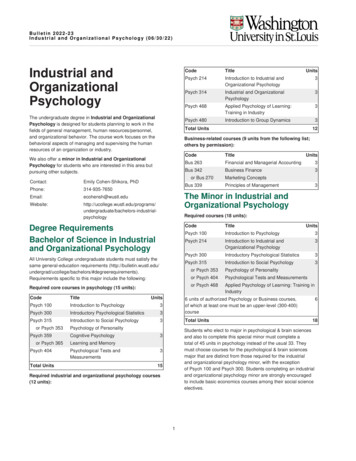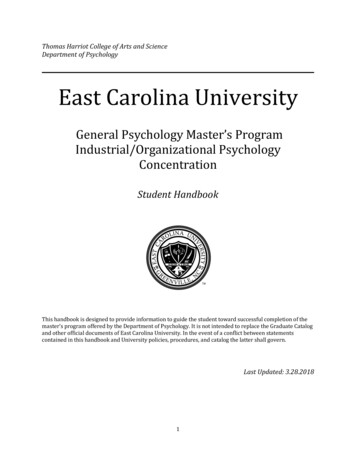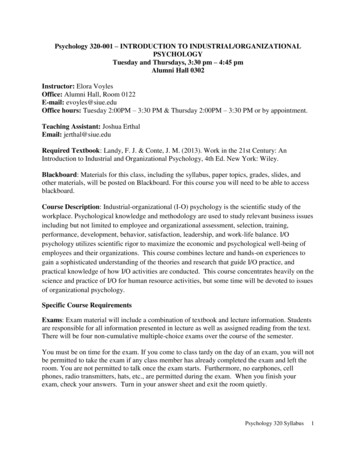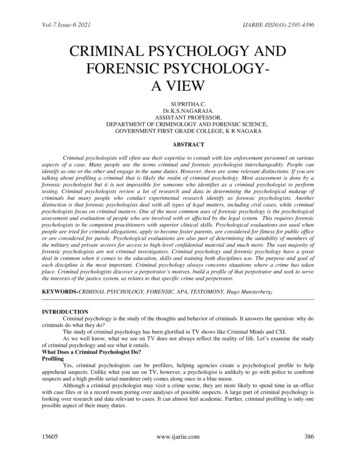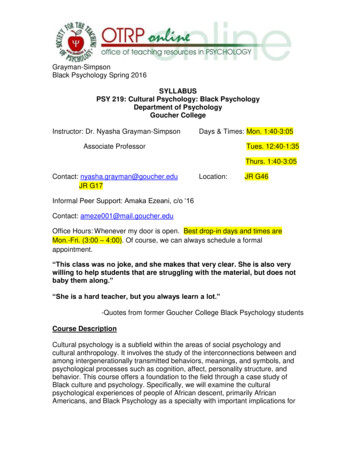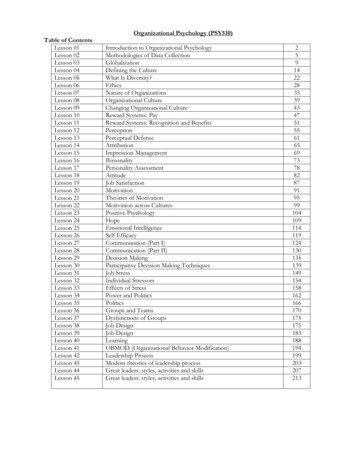
Transcription
Organizational Psychology (PSY510)Table of ContentsLesson 01Lesson 02Lesson 03Lesson 04Lesson 05Lesson 06Lesson 07Lesson 08Lesson 09Lesson 10Lesson 11Lesson 12Lesson 13Lesson 14Lesson 15Lesson 16Lesson 17Lesson 18Lesson 19Lesson 20Lesson 21Lesson 22Lesson 23Lesson 24Lesson 25Lesson 26Lesson 27Lesson 28Lesson 29Lesson 30Lesson 31Lesson 32Lesson 33Lesson 34Lesson 35Lesson 36Lesson 37Lesson 38Lesson 39Lesson 40Lesson 41Lesson 42Lesson 43Lesson 44Lesson 45Introduction to Organizational PsychologyMethodologies of Data CollectionGlobalizationDefining the CultureWhat Is Diversity?EthicsNature of OrganizationsOrganizational CultureChanging Organizational CultureReward Systems: PayReward Systems: Recognition and BenefitsPerceptionPerceptual DefenseAttributionImpression ManagementPersonalityPersonality AssessmentAttitudeJob SatisfactionMotivationTheories of MotivationMotivation across CulturesPositive PsychologyHopeEmotional IntelligenceSelf EfficacyCommunication (Part I)Communication (Part II)Decision MakingParticipative Decision Making TechniquesJob StressIndividual StressorsEffects of StressPower and PoliticsPoliticsGroups and TeamsDysfunctions of GroupsJob DesignJob DesignLearningOBMOD (Organizational Behavior Modification)Leadership ProcessModern theories of leadership processGreat leaders: styles, activities and skillsGreat leaders: styles, activities and 8194199203207213
Organizational Psychology (PSY510)VULesson 01INTRODUCTION TO ORGANIZATIONAL PSYCHLOGYOrganizational Psychology is the understanding, prediction and control of human behaviour in organizations.As noted by well-known international management scholar Geert Hofstede, “Because management is alwaysabout people, its essence is dealing with human nature. Since human nature seems to have been extremelystable over recorded history, the essence of management has been and will be equally stable over time.”Therefore the essence of Organizational Psychology remains in trying to better understand and effectivelymanage human behaviour in organizations.Foundations/Background of organizational psychology reveals two main sources of information: Anthropology: It is the study of manSociology: It is the science of society, study of social aggregatesManagement is considered to be faced by three major dimensions, technical, conceptual, and human.Psychologists realized the importance of the human dimension of management to the extent that theorieswere developed to understand human behaviour in organizations. An example of such a theory was DouglasMcGregor’s Theory X according to which most managers thought that their employees were indolent andlazy. This approach was considered to be successful in managing the human element for a long time. Later itwas revealed that that the approach no longer worked with the current environmental demands. The impactof globalization, technological advancement, fast pace of life and all such changes in the organizationalenvironment have caused the behaviour of employees in the organization to be influenced dramatically. Theold approaches hold little worth today and new research is being done under the umbrella of OrganizationalPsychology in order to understand human behaviour in the modern day environment. It was realized byscientists that through little simulation, lab knowledge can be applied to organizations such as industry, banks,stock exchanges, colleges, universities, offices.It is important that we adopt the new approaches towards organizational psychology and it can be done bylooking at old models and paradigms to be scrutinized and new concepts and models to be discovered andapplied by empirical research.Organizational psychology is also known as the study of organizational behaviour. It is a diverse branch ofpsychology which incorporates various aspects of other fields of psychology and human resourcemanagement, including, social psychology, personality psychology, quantitative psychology includingpsychometrics.Initially, Organizational Psychology was not distinguished from vocational psychology or the study of humanfactors. Today Organizational Psychology is considered to be a separate discipline in all over the world, beingtaught in almost all universities offering psychology courses. Organizational psychologists specialize in one ofthe following aspects: psychometrics; quality; employment law; personnel selection; training; leadershipselection, coaching and development; organizational design and change. Some Organizational Psychologistsare academic (working in both business and psychology departments) or nonacademic researchers, whilemany others are engaged in practice, holding positions such as executive coach; counsellor; diversityconsultant; legislative compliance officer etc.Financial compensation of industrial and organizational psychologists generally is among the highest in thewhole field of psychology. While salary and benefits tend to be significantly greater in the private sector,academics who specialize in industrial and organizational psychology may command greater compensationthan their faculty peers. Teaching (and sometimes research) opportunities exist in business schools as well asin psychology programs. Business schools typically offer more generous salaries and benefits than dopsychology programs. Copyright Virtual University of Pakistan2
Organizational Psychology (PSY510)VUComing to the history of Organizational Psychology, it differs country by country. In the United States, itsorigins are those of applied psychology in the early 20th Century, when the nation was experiencingtremendous industrialization, corporatization, unionization, immigration, urbanization and physicalexpansion. Arguably, the field's greatest early pioneers were Hugo Münsterberg (1863-1916), Walter Dill Scott(1869-1955) and Walter Van Dyke Bingham (1880-1952). As in other countries, wartime necessity (e.g.,World War I and World War II) led to the discipline's substantial growth. Business demand for scientificmanagement, selection and training also has promoted and sustained the field's development.Organizational psychologists may adopt one of the following approaches to view their subject matter andgather data: Behaviouristic Approach as that of Pavlov or Cognitive Approach as that of FreudOne of the tools that organizational psychologists commonly utilize in the field is called a job analysis. Jobanalyses identify essential characteristics associated with any particular position through interviews of jobincumbents, subject matter experts, supervisors and/or past job descriptions. Job analysis measures bothworker facets necessary to perform the job adequately (aka KSAOs - knowledge, skills, abilities, and othercharacteristics (such as personality, beliefs, and attitudes) as well as unique facets of the job itself. Once a jobanalysis is complete, I/O psychologists will typically utilize this information to design and validate systems toselect new applicants, restructure employee performance appraisals, uncover training needs, and analyzefairness in employee compensation. Though a thorough job analysis takes time, resources and money, itsbenefits tend to outweigh the costs. Organizational psychologists also may employ psychometric tests tomeasure employee attitudes such as morale, job satisfaction, or feelings towards management or customers.The major determinant of organizational performance is the human factor in an organization. Psychologiststherefore advise senior managers on the management of organizational climate or culture, on dealing withorganizational change, or on group dynamics within an organization. This all is a part of organizationalpsychology.Hawthorne Effect:The Hawthorne effect was discovered in 1924 at Hawthorne works at Western Electric Company; Chicago,USA. The Hawthorne effect refers to the phenomenon that when people are observed in a study, theirbehavior or performance temporarily changes. A series of experiments was conducted in the factory between1924 and 1932.There were many types of experiments conducted on the employees, but the purpose of the original ones wasto study the effect of lighting on workers’ productivity. When researchers found that productivity almostalways increased after a change in illumination, no matter what the level of illumination was, a second set ofexperiments began, supervised by Harvard University professors Elton Mayo, Fritz Roethlisberger andWilliam J. Dickson. They experimented on other types of changes in the working environment, using a studygroup of five young women. Again, no matter the change in conditions, the women nearly always producedmore. The researchers reported that they had accidentally found a way to increase productivity. The effectwas an important milestone in industrial and organizational psychology and in organizational behaviour.However, some researchers have questioned the validity of the effect because of the experiments’ design andfaulty interpretations.As mentioned earlier the Hawthorne studied included a number of experiments which includes; Illumination studiesRelay assembly experimentsBank wiring room experimentsMica splitting test room Copyright Virtual University of Pakistan3
Organizational Psychology (PSY510)VUThe results of the studies were:1. Small groups were better. When people in an organization worked in small groups, their performanceimproved. This was one of the conclusions drawn from the Hawthorne Studies.2. Type of super-vision matters. The performance of the workers in organization is also influenced by thetype of supervision given to them.3. Interest matters. The interest of the workers in the work and the interest of the managers in theperformance of the workers play a role in improving their performance.4. Novelty of situation mattersThe novelty of the situation into which a worker is put also matters. A worker may perform better in a novelworking situation.As mentioned earlier, the Hawthorne studies were a break through in the field of Organizational Psychology.It was perhaps the first experiment of its kind that laid the foundation of further studies in the field. Copyright Virtual University of Pakistan4
Organizational Psychology (PSY510)VULESSON 02METHODOLOGIES OF DATA COLLECTIONPsychologists use some of the following methods for research and data collection:Experimental Method : The experimental research design is when a cause-and-effect relationship betweenan independent and a dependent variable of interest is to be clearly established, then all other variable thatmight contaminate or confound the relationship have been tightly controlled. In other words, the possibleeffects of other variables on the dependent variable have been accounted for in some way. Independent Variable: An independent variable is one that influences the dependent variable ineither a positive or negative way. That is, when the independent variable is present, the dependentvariable, there is an increase or decrease in the dependent variable also. In other words, the variancein the dependent variable is accounted for by the independent variable. To establish causalrelationships, the independent variable is manipulated. Dependent Variable: The dependent variable is the variable of primary interest to the researcher.The researcher’s goal is to understand and describe the depend variable, or to explain its variability,or predict it. In other words, it is the main variable that lends itself for investigation as a viable factor.Through the analysis of the dependent variable (i.e., finding what variables influence it), it is possibleto find answers or solutions to the problem. For this purpose, the researcher will be interested inquantifying and measuring the dependent variable, as well as the other variables that influence thisvariable. Intervening Variable: An intervening variable is one that surfaces between the time theindependent variables start operating to influence the dependent variable and the time their impact isfelt on it. The intervening variable surfaces as a function of the independent variable(s) operating inany situation, and helps to conceptualize and explain the influence of the independent variable(s) onthe dependent variable.Control:When we postulate cause-and-effect relationships between two variables X and Y, it is possible that someother factors, say A, might also influence the dependent variable Y. In such a case, it will not be possible todetermine the extent to which Y occurred only because of X, since we do not know how much of the totalvariation of Y was caused by the presence of the other factor A. For instance a Human ResourceDevelopment manager might arrange for special training to a set of newly recruited secretaries in creatingweb pages, to prove to his boss that such training would cause them to function more effectively. However,some of the new secretaries might function more effectively than others, mainly or partly because they havehad previous intermittent experienced with the web. In this case the manager cannot prove that the specialtraining alone caused greater effectiveness, since the previous intermittent experience of some secretaries withthe webs is a contamination factor. If the true effect of the training on learning is to be assessed, then thelearner’s previous experience has to be controlled. This is what be mean when we say we have to control thecontamination factors.Observational method:It is possible to gather data without asking questions of respondents. People can be observed in their naturalwork environment or in the lab setting, and their activities and behaviours or other items of interest can be Copyright Virtual University of Pakistan5
Organizational Psychology (PSY510)VUnoted and recorded.Apart from the activities performed by the individuals under study, their movements, work habits, thestatements made and meetings conducted by them, their facial expressions of joy, anger, and other emotions,and body language can be observed. Other environmental factors such as layout, work-flow patterns, thecloseness of the seating arrangement, and the like, can also be noted. This is called observational method ofcollecting data.Case design: study of a particular caseCase studies involve in-depth contextual analyses of similar situations in other organizations, where the natureand definition of the problem happen to be the same as experienced in the current situation. Hypothesis canbe developed in case studies as well.Longitudinal methodsThe researcher might want to study people or phenomenon at more than one point in time in order toanswer the research question. For instance, the researcher might want to study employees’ behaviour beforeand after a change in the top management, so as to know what effects change accomplished. Here, becausedata are gathered at two different points in time, the study is carried longitudinally across a period of time.Such studies are called longitudinal studies and the method as longitudinal methods.Survey design; Study of aggregatesSurvey design may be called the study of aggregates which means that the data are collected through variousinstruments such as questionnaires, interviews etc. to gather the information about the variables.Cross sectional methodsA study can be done in which data are gathered just once, perhaps over a period of days or weeks or months,in order to answer a research question. Such studies are called one-shot or cross-sectional studies.Concepts Of Reliability And Validity:Reliability:The reliability of a measure indicates the extent to which it is without bias (error free) and hence ensuresconsistent measurement across time and across the various items in the instrument. In other words, thereliability of a measure is an indication of the stability and consistency with which the instrument measure theconcept and helps to assess the “goodness” of a measureStability of Measures:The ability of a measure to remain the same over time—despite uncontrollable testing conditions or the stateof the respondents themselves—is indicative of its stability and low vulnerability to changes in the situation.This attests to its “goodness” because the concept is stably measured, no matter when it is done. Two tests ofstability are test-retest reliability and parallel-form reliability. Copyright Virtual University of Pakistan6
Organizational Psychology (PSY510)VUTest-retest Reliability:The reliability coefficient obtained with a repetition of the same measure on a second occasion is called testretest reliability. That is, when a questionnaire containing some items that are supposed to measure a conceptis administered to a set of respondents now, and again to the same respondents, say several weeks to 6montslater then the correlation between the scores obtained at the two different times from one and the same setsof respondents is called test-retest coefficient. The higher it is, the better the test—retest reliability, andconsequently, the stability of the measure across time.Parallel-Form Reliability:When responses on two comparable sets of measures tapping the same construct are highly correlated, wehave parallel-form reliability Both forms have similar items and the same response format, the only changesbeing the wording and the order or sequence of the questions. What we try to establish here is the errorvariability resulting from wording and ordering of the questions. If two such comparable forms are highlycorrelated (say 8 and above), we may be fairly certain that the measures are reasonably reliable, with minimalerror variance caused by wording, order, or other factors. Examples (test-retest, split half.Split-Half Reliability:It is another measure or reliability which measure the internal consistency of measures. The internalconsistency of measures is indicative of the homogeneity of the items in the measure that tap the construct.In other words, the items should “hang together as a set, “ and be capable of independently measuring thesame concept so that the respondents attach the same overall meaning to each of the items.Split-half reliability reflects the correlations between two halves of an instrument. The estimates would varydepending on how the items in the measure are split into two halves. For example, if we split a question areinto two parts and administer them independently, we may be able to check if the answers to the first half areconsistent with those to the second.Validity:It refers to the fact that when we ask a set of questions (i.e., develop a measuring instrument) with the hopethat we are tapping the concept, how can be we reasonably certain that we are indeed measuring the conceptwe set out to do and not something else? This can be determined by applying certain validity tests. Severaltypes of validity tests are used to test the goodness of measures and writers use different terms to denotethem. However, validity tests may the grouped under the following headings:Content validity:Content validity ensures that the measure includes an adequate and representative set of items that tap theconcept. The more the scale items represent the domain or universe of the concept being measured, thegreater the content validity. To put it differently, content validity is a function of how well the dimensions andelements of a concept have been delineated.A panel of judges can attest to the content validity of the instrument. Kidder and Judd (1986) cite theexample where a test designed to measure degrees of speech impairment can be considered as having validityif it is so evaluated by a group of expert judges (i.e., professional speech therapists). Copyright Virtual University of Pakistan7
Organizational Psychology (PSY510)VUPredictive/Criterion validity:It is established when the measure differentiates individuals on a criterion it is expected to predict. This canbe done by establishing concurrent validity or predictive validity. Concurrent validity is established when thescale discriminates individuals who are known to be different; that is, they should score differently on theinstrument.Predictive validity indicates the ability of the measuring instrument to differentiate among individuals withreference to a future criterion. For example, if an aptitude or ability test administered to employees at the timeof recruitment is to differentiate individuals on the basis of their future job performance, then those whoscore low on the test should be poor performers and those with high scores good performers.Construct validity:It testifies to how well the results obtained from the use of the measure fit the theories around which the testis designed. In other words, it shows relationship of characteristic with other observable constructs. Copyright Virtual University of Pakistan8
Organizational Psychology (PSY510)VULESSON 03GLOBALIZATIONGlobalization may simply be defined as the free movement of: CapitalLabourGoods and servicesacross various countries of the world.According to the Wikipedia online encyclopedia, Globalization refers to a process of increasing globalconnectivity and integration between nation-states, households/individuals corporations and otherorganizations. It is an umbrella term referring to increased interdependence in the economic, social,technological, cultural, political, and ecological spheres. In the context of global trade, the term Globalizationis the opposite of protectionism. Theodore Levitt is usually credited with globalization's first use in aneconomic context.The IMF International Monetary Fund stresses the growing economic interdependence of countriesworldwide through increasing volume and variety of cross-border transactions . free international capitalflows, and more rapid and widespread diffusion of technologyA less economic-focused definition from the Encyclopedia Britannica states that globalization is the "processby which the experience of everyday life . is becoming standardized around the world."The question arises that is globalization just a buzzword or is it a real phenomenon? The world in which welive today, the word distance here has virtually no meanings in it. You can move around the globe in lessertime than the globe takes to revolve around its own axis. In other words, the different parts of the worldseem to be connected and moving from one part to another is not a big deal today. A few centuries fromtoday, man had to travel months on land and through sea to reach from one continent to another. Trade wasvery slow and its volume was negligible as compared to today. But today, as we see, this is no more the case;ships, aircrafts and land transport is fast enough to cover the distance or around the globe in no more than afew hours. This is resulted in brining together various countries and culture of the world. People are nowmore dependent on each other. For instance, the United States is depended in most of its goods on China,whereas many countries are dependent on Pakistan for the supply of crops. Therefore, the world has becomewhat we call a “Global Village.” Although its huge, yet the dependencies have rendered the world like a smallvillage where everyone has to play its part for everybody else’s survival.Further question arises that is Globalization a recent phenomenon? The phenomenon of Globalization wasgiven much more importance during the last few decades and the general perception is that Globalization is arecent phenomenon. In fact, Globalization has been on since the history of mankind. If we trace back thehistory of mankind, we would find the earliest well-recorded history is that of the Egyptian civilization. TheEgyptian civilization was established around river Nile. It was discovered that the Egyptians used to tradewood through this river. Later during the Roman and the Greek civilization, trade was not uncommon.Therefore, we see that since long, man has been involved in conducting commerce and trade across countriesand dependencies have been created since long. The city states of Samarkand and Bokhara are said to haveflourished because of trade which was carried out between Asia and Europe during the 16th and the 17thcenturies. This should make it clear that the path towards Globalization was paved centuries ago, only thepace has increased rapidly today. This is why today we feel that Globalization is a recent phenomenon. Copyright Virtual University of Pakistan9
Organizational Psychology (PSY510)VUAspects Of Globalization:We have already discussed what Globalization is; in order to get a better picture of the impact ofGlobalization of the lives of human beings, we need to consider the various aspects of Globalization whichmay be categorized as follows:Industrial Globalization:Every country in the world is moving towards specialization. Specialization may be referred to as thephenomenon of producing only that product in which the country has competitive advantage in terms ofcost. For example, Singapore specializes in pharmaceutical while the US specializes in military equipment.Therefore, the countries exchange their industrial products, which is known as trade, and fulfill therequirements of their people. Every country of the world today is involved in trade and is depended on someother country one way or the other. The US is the biggest economy in the world and even that is dependedon other countries for many of its needs. Hence the industries of the world today are considered to beworking not for their native countries but for the world as a whole. This is known as Industrial Globalization.Furthermore, today various world-wide standards have been developed which ensure that the products of allthe countries around the world meet certain quality requirements. For example the ISO 9000 standards areapplicable worldwide as quality standards. The markets of the world have united and the products could besold anywhere without any hindrance. In other words emergence of worldwide production markets andbroader access to a range of goods for consumers and companies is known as Industrial Globalization.Financial Globalization:It may be defined as the emergence of worldwide financial markets and better access to external financing forcorporate, national and sub-national borrowers. For example, the Tarbela Dam and the Mangle Dam projectsin Pakistan were sponsored by foreign investors. They may be in the form of international organizations orindependent investors. The IMF and the World Bank today give funds to various countries for developmentalprojects. We may say, that today the financial markets of the world have untied in such a way that finances areeasily available throughout the world. This is known as Financial Globalization.Political Globalization:This may simply be defined as the development of political interests of countries in other countries.Informational Globalization:This aspect of Globalization has perhaps had the greatest impact on the world today. Sitting at one end of theworld, you can have access to the information available in any other part of the world with just the push of abutton. Internet, television, telephone, fax, etc. are some of the inventions that may be considered as a part ofthe informational Globalization process where the information flow has dramatically increased betweengeographically remote areas of the world.Cultural Globalization:In the context of Organizational Psychology, this is another important aspect of Globalization which refers tothe growth of cross-cultural contacts. The cultures of the world have become similar and have had influencefrom one another in many ways. This has changed the environment of mankind and it is known as CulturalGlobalization. Copyright Virtual University of Pakistan10
Organizational Psychology (PSY510)VUEffects of Globalization:As discussed earlier, Globalization refers to the greater international movement of commodities, money,information, and people; and the development of technology, organizations, legal systems, and infrastructuresto allow this movement. The effects that Globalization has had on the modern day living of mankind are asfollows: International Cultural exchange MulticulturalismDiversityGreater international travel and tourismGreater immigration, including illegal immigrationSpread of local consumer products (e.g., food) to other countries (often adapted to their culture)World-wide fads and fashionsWorld-wide sporting events such as Cricket world cupFormation or development of a set of universal valuesDevelopment of a global telecommunications infrastructureGreater trans-border data flow,Increase in the number of standards applied globally; e.g. copyright laws, patents and world tradeagreements.International criminal court and international justice movements.Development of world-wide commerceImprovement in standard of livingCorporate Imperialism: Dominance of MNCsCultural ImperialismHarmful effects on environment due to rapid industrializationSuppressing of underdeveloped countriesGreater market access for firms Globalization has also affected OP in major ways; Trade between nations has become huge 6 million foreign nationals are employed by 100 companies 450,000 multinationals exist today Every organization is moving towards diversity in order to have diverse view points from within theorganizationInformation Globalization has affected the work and organizations in seven ways Flattening: Organizations have today have smaller hierarchy and layers of management Downsizing: Organizations employee lesser number of employees today for the same jobs as it did Copyright Virtual University of Pakistan11
Organizational Psychology (PSY510)VUpreviously due to dependence on machines. Paperlessness: Organizations are dependent on paperless communication, i.e., communicationsthrough comp
Financial compensation of industrial and organizational psychologists generally is among the highest in the whole field of psychology. While salary and benefits tend to be significantly greater in the private sector, academics who specialize in industrial and organizational psychology may command greater compensation than their faculty peers.
